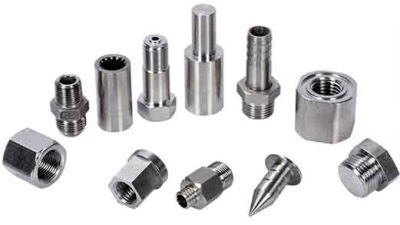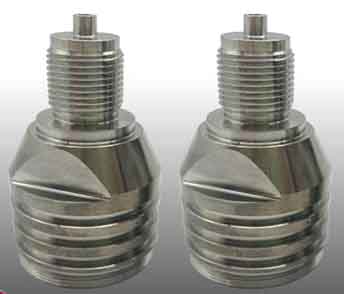Problemas de torneamento CNC de roscas de aço inoxidável e contramedidas
A rugosidade da superfície da rosca de torneamento CNC é muito baixa. O fenômeno mais comum encontrado no torneamento CNC de roscas de aço inoxidável é: ondulações semelhantes a escamas e fenômeno de mordida de faca. As razões para esses fenômenos são:
(1) The clearance angles of the two sides of the thread turning tool are too small, and the friction between the two sides of the cutting tool and the rear thread surface will deteriorate the machined surface. The influence of the thread rotation angle on the actual clearance angle of both edges must be considered during processing.
(2) The rake angle of the thread turning tool is too small and the cutting edge is not sharp enough. The chips cannot be cut smoothly, but are partially squeezed or torn off, which must cause the thread surface to be very rough. When the front angle is too large, the strength of the blade is weakened and it is easy to wear, chip, and pierce the knife, which is more likely to cause vibration and cause ripples on the thread surface. Portanto, the appropriate rake angle should be selected according to the different materials of stainless steel. When turning concentrated sulfuric acid resistant stainless steel threads, a smaller rake angle should be used than turning 2Cr13 stainless steel threads. As arestas de corte em ambos os lados da ferramenta de torneamento devem ter arestas de corte muito estreitas para evitar desgaste rápido das arestas de corte. Ao cortar 2Cr13, 1Cr17, 4Cr13, a aresta de corte deve ser o mais afiada possível, caso contrário, não será fácil alcançar a boa rugosidade superficial necessária.

Processo de torneamento de rosca em aço inoxidável
(3) a lâmina do cortador de linha está cega, na verdade, o ângulo de inclinação, ângulo de relevo de grande para pequeno, os chips espremidos no processo de formação severo, de modo que a força de corte aumente durante o aumento da vibração de corte, deterioração grave da superfície usinada. Portanto, ao girar roscas de aço inoxidável, a lâmina deve ser mantida sempre afiada e a cabeça do cortador deve ser substituída a tempo.
(4) Fixação insuficiente de ferramentas de torneamento roscado, cabeças de ferramenta excessivamente estendidas, rigidez insuficiente do eixo da ferramenta, baixa precisão da máquina-ferramenta, fusos soltos, porta-ferramentas soltos e outros fatores podem causar vibração e ondulações na superfície roscada. Portanto, você deve prestar atenção ao funcionamento da máquina-ferramenta, ferramenta de corte e peça de trabalho durante a operação para tornar o sistema suficientemente rígido. Ao instalar a ferramenta de torneamento, além de garantir uma instalação firme e sem folgas, a ponta da ferramenta de torneamento deve estar ligeiramente acima do centro da peça de trabalho em 0,2-0,5 mm, e nunca abaixo do centro para evitar cortar a ferramenta.
(5) Evite usar o método direto ao girar roscas de aço inoxidável. Devido ao longo comprimento de contato do cavaco nos lados esquerdo e direito, é propenso a vibração, o que aumenta a carga na ponta da ferramenta, causa vibração e aumenta a resistência durante a remoção de cavacos, e arranha a superfície da peça de trabalho. Portanto, para o processamento de roscas de aço inoxidável, é melhor escolher o método de torneamento cruzado de roscas. Este método adota o método de alimentação lateral alternativo, especialmente para o corte de roscas de grande passo e materiais viscosos. É a medida mais eficaz para resolver o problema de vibração. Como as arestas de corte são usadas transversalmente, o desgaste é uniforme e a vida útil da ferramenta pode ser prolongada.
(6) O grau de correspondência da quantidade de corte no processo de corte CNC de roscas de aço inoxidável afeta diretamente a eficiência do processamento. Se a quantidade de corte for muito pequena, o desgaste da ferramenta será agravado, e se for muito grande, a ferramenta entrará em colapso. Portanto, o número de cortes e o avanço por corte terão influência decisiva no torneamento da rosca. In order to obtain the best tool life, the workpiece diameter should not be larger than the major thread diameter 0.14mm, and the feed per tool less than 0.05mm should be avoided. The total cutting amount for machining should be set at about 0.1mm, the first cut depth should be 150-200% of the nose radius (R), and the maximum should not exceed 0.5mm. For austenitic stainless steel, a feed per cut of less than 0.08mm should be avoided. Common edge inserts with a small nose radius for internal threads may increase the number of cuts as the depth of the tool decreases. Thread size is unstable after CNC turning stainless steel. After thread processing. Use a thread ring gauge to measure that the “through end” of the external thread cannot be entered, or there are phenomena such as inconsistencies in the front and rear tightness and partial passage of the “stop end”.

Cooling lubricant for turning stainless steel thread
Reasons for these ills of thread:
(1) The thread profile is wrong. Even if the pitch diameter of the thread has reached the specified size, the thread ring gauge and plug gauge may still not be screwed.
(2) The thread is inverted. When measuring with a thread gauge, there is often a phenomenon that is restricted by the directionality. That is to say, it is tightened from one end and loosened from the other end, and even the phenomenon that the “through end” cannot pass but the “stop end” passes instead.
(3) If the bottom diameter of the internal thread is too small, or the bottom diameter of the external thread is too large, the thread gauge will not be screwed in. This is because the turning tool wears and becomes dull, and there is extrusion during the cutting process, which makes the outer diameter or inner diameter of the thread squeeze out of burrs.
(4) When turning internal threads with a small diameter, the rigidity of the turning tool bar is limited by the size. Durante o processo de torneamento, it is easy to produce “give a knife”, and even the local size is large, which causes the local tolerance to be out of tolerance.
(5) When turning the stainless steel slender screw, due to the poor rigidity of the workpiece, deformation occurs during the turning process, resulting in dimensional errors on the thread.
(6) When turning the internal and external threads of stainless steel thin-walled workpieces, the workpiece will be locally deformed due to the force and cutting temperature, and the thread will also be locally out of tolerance. Portanto, in order to solve the problem of “the thread gauge cannot enter”, corresponding measures must be taken for the above reasons, mainly from the aspects of correct installation and proper clamping of the workpiece.
The subtle role of cooling lubricating fluid in CNC thread cutting
Reasonable use of lubricating fluid can improve cutting conditions and achieve a multiplier effect. Attention should be paid when CNC cutting stainless steel threads:
Special requirements for cooling lubricants:
(1) Due to the toughness of stainless steel and the difficulty of being separated by cutting, the coolant is required to have higher cooling performance to take away a lot of heat.
(2) Devido à alta viscosidade e alta propriedade de fusão, é fácil produzir arestas postiças durante o corte de rosca, então o refrigerante deve ter alto desempenho lubrificante.
(3) O refrigerante deve ter boa permeabilidade, que pode penetrar nas linhas finas da área de metal durante o corte, para que os chips sejam facilmente quebrados.
(4) Deve ter uma certa função de lavagem.
Use vários refrigerantes adequados
(1) O óleo vulcanizado tem bom desempenho de resfriamento e desempenho de lubrificação, e podem ser divididos em diretos e indiretos de acordo com diferentes métodos de preparação. A fórmula do óleo fluidizado direto é 98% óleo mineral e 2% enxofre. A fórmula do óleo sulfurado indireto é: óleo mineral 78%-80%, óleo de motor preto, óleo vegetal 18%-20%, e enxofre 1.7%.
(2) O óleo F43 é adequado para resfriar e lubrificar cortes de aço inoxidável, and has the best effect on stainless steel threads. The formula is: No. 5 high-speed motor oil 83.5%, calcium petroleum sulfonate 4%, barium petroleum phosphate 4%, oxidized petroleum fat barium soap 4%, zinc dialkylthiophosphate 4%, and disulfide 0.5%.
(3) Vegetable oil, such as soybean oil, helps to obtain better thread surface roughness and prolong tool life when turning threads.
Resumindo, whether it is martensitic stainless steel, ferritic stainless steel or austenitic stainless steel, or even austenitic + ferritic stainless steel, corresponding thread processing methods should be developed according to different metallographic structures . In order to achieve the ideal processing effect, create more economic and social benefits.
 English
English العربية
العربية 中文(漢字)
中文(漢字) Čeština
Čeština Dansk
Dansk Nederlands
Nederlands Suomi
Suomi Français
Français Deutsch
Deutsch Italiano
Italiano 日本語
日本語 ಕನ್ನಡ
ಕನ್ನಡ 한국어
한국어 Português
Português Русский
Русский Slovenčina
Slovenčina Español
Español Svenska
Svenska Türkçe
Türkçe

